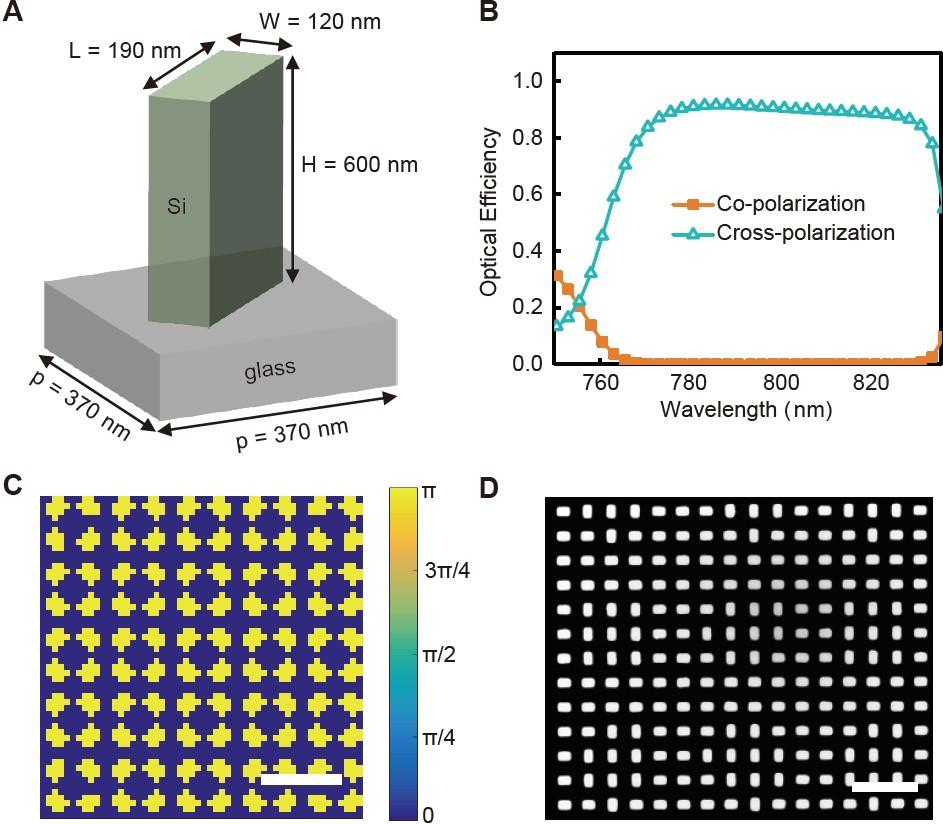Ground-breaking international research directed by scholars at Southern University of Science and Technology (SUSTech) has demonstrated the first metasurface optical chip for generating cold atomic ensembles. It provides a novel scheme for the realization of a single beam Magneto-Optical Trap (MOT). Their research could have broad applications in quantum metrology, quantum information processing, and atomic physics.
On June 29, an international and interdisciplinary research team led by Associate Professor Guixin Li (Materials Science and Engineering, Shenzhen Institute of Quantum Science and Engineering) published cutting-edge research findings. Their findings provide a unique approach for preparing cold atoms. Their paper, titled “A Dielectric Metasurface Optical Chip for the Generation of Cold Atoms,” was published in the high-impact academic journal, Science Advances (IF = 13).
Cold atom ensembles provide an ideal platform for fields such as quantum sensing, quantum metrology, and quantum simulation. Generating cold atom quantum devices usually need cold-atom ensembles that require laser cooling and trapping techniques. Hot gas-phase atoms can be typically cooled and trapped using a magneto-optical trap (MOT). The standard MOT apparatus uses three orthogonal pairs of laser beams of appropriate circular polarizations. However, these tend to take up a lot of space. Researchers have been investigating new MOT variations, which tend to be either more robust or more efficient.
One recent development that has shown promise is a metasurface optical device composed of different subwavelength structures. These are also known as meta-atoms and can control the amplitude, polarization, and phase of light waves. Metasurface-based optics have the potential to replace or complement their conventional counterparts due to their versatility, flexibility, and simple fabrication technique. Recent literature on the topic has indicated that metasurfaces have enormous potential in quantum optics. That includes areas such as quantum metasurface interferometers, quantum entanglement state generation, and reconstruction.

Fig. 1. Schematic of the cold atom generator with the dielectric metasurface optical chip
The paper provided the first demonstration of the use of metasurface optical chips as a new approach for the generation of cold atoms. They assessed the atom ensemble’s performance through realizing initial atom numbers and temperatures commensurate with quantum sensing. They achieved temperatures comparable to what researchers would get with similar setups and boundary conditions in standard MOT systems. Their experimental proof did not show any temperature-based limitations imposed by metasurface technology. The temperature of the atoms is sufficient for compact high-bandwidth atom interferometers. It is also similar to the temperatures used when loading magnetic traps for further evaporative cooling to BEC.
One pathway to further reduce the temperature would apply the function of similar optimization techniques as used in standard MOTs. The paper provided a promising new approach for realizing compact and future commercial quantum sensors. It focused on enabling more compact and lower power systems. It also opened a new direction in the application of metasurface for drastically improving the delivery of atom optics or optical lattices. There are further research directions to examine through the changing of capabilities in a wide range of quantum sensing modalities.

Fig. 2. Design and fabrication of the metasurface optical chip. (A) The geometric configuration of the Si meta-atom with period p = 370 nm, meta-atom length L = 190 nm, width W = 120 nm, and height H = 600 nm. (B) Simulated cross-polarization and co-polarization conversion efficiency for different wavelengths of the incident light. (C) The calculated phase profile of the metasurface optical chip

Fig. 3. Performance of the metasurface-based MOT. (A) Variation of the number of atoms trapped in the metasurface-based MOT with the laser detuning. (B) Absorption images of the 87Rb cloud at expansion times after MOT. (C) The fitted radii of the 87Rb cloud in the axial (circles) and radial (triangles) directions versus the expansion time t. (D) Absorption images of the 87Rb cloud at expansion times after optical molasses
The University of Birmingham Dr. Lingxiao Zhu, SUSTech Dr. Xuan Liu, the University of Paderborn Dr. Basudeb Sain, and the University of Birmingham Dr. Mengyao Wang are the co-first authors of the paper. Dr. Guixin Li and the University of Birmingham Dr. Yu-Hung Lien are the co-correspondent authors. SUSTech Dr. Junhong Deng, Dr. Kingfai Li, and Ph.D. student Yutao Tang from the Department of Materials Science and Engineering also made vital contributions to this study.
This work is supported by the National Natural Science Foundation of China, the Guangdong Provincial Innovation and Entrepreneurship Project, and the Qiu Shi Science & Technologies Foundation.
Article link: https://advances.sciencemag.org/content/6/31/eabb6667
Proofread ByYingying XIA
Photo ByDepartment of Materials Science and Engineering, Yan QIU